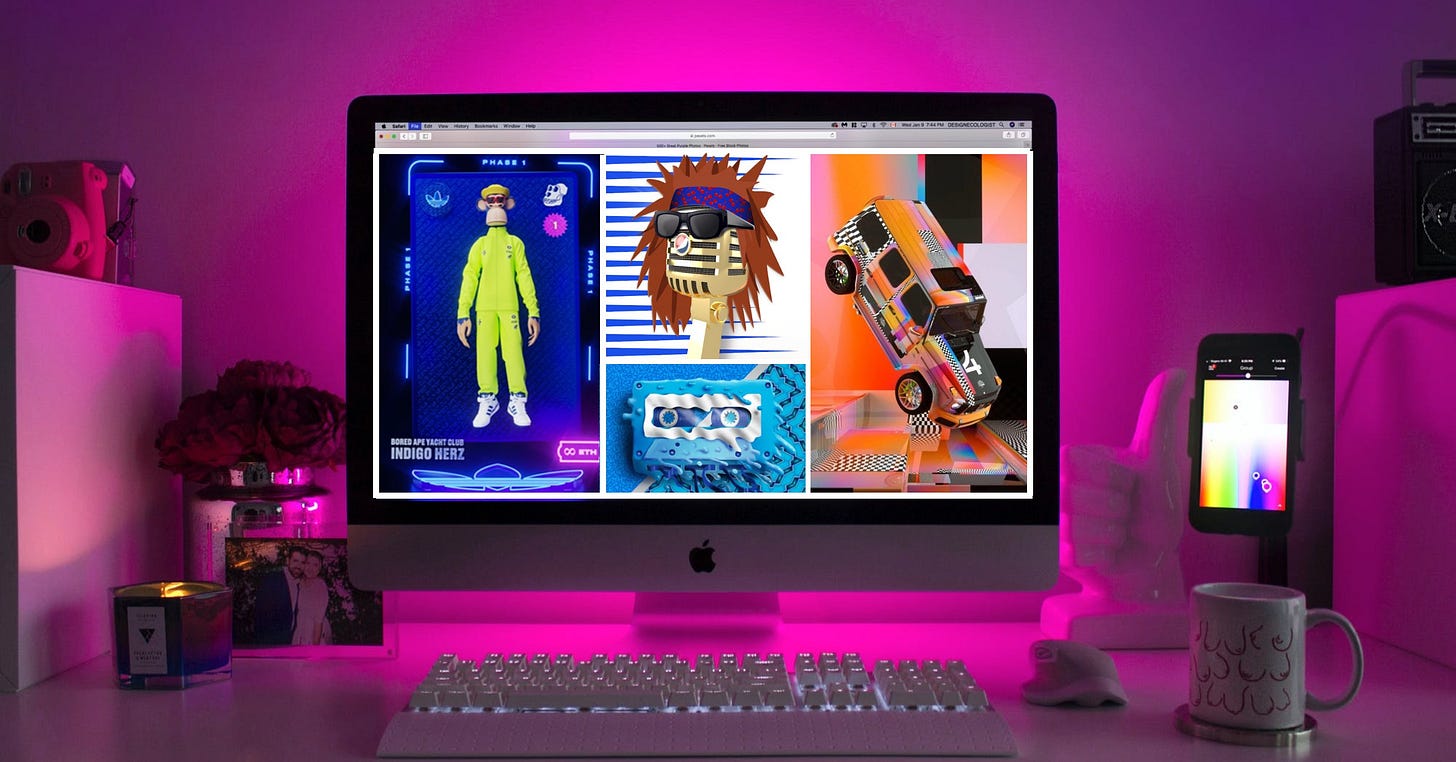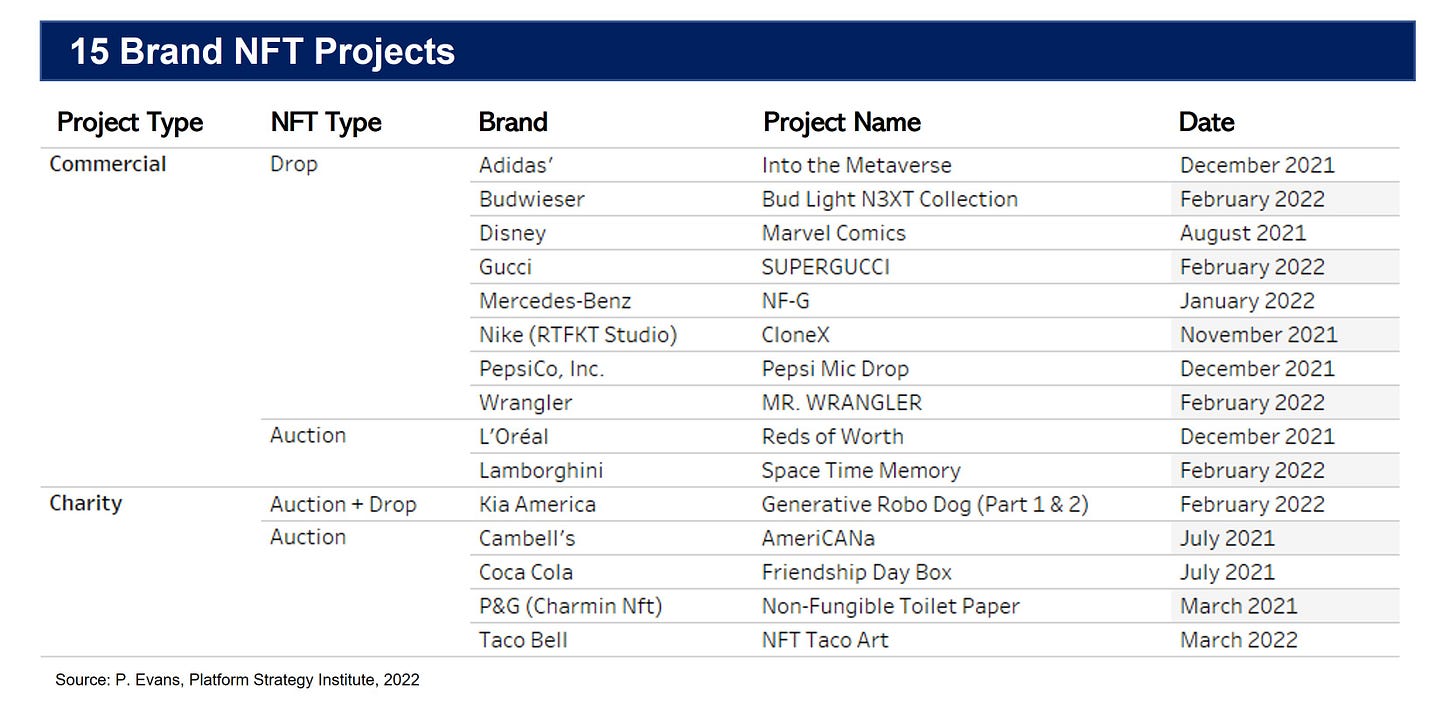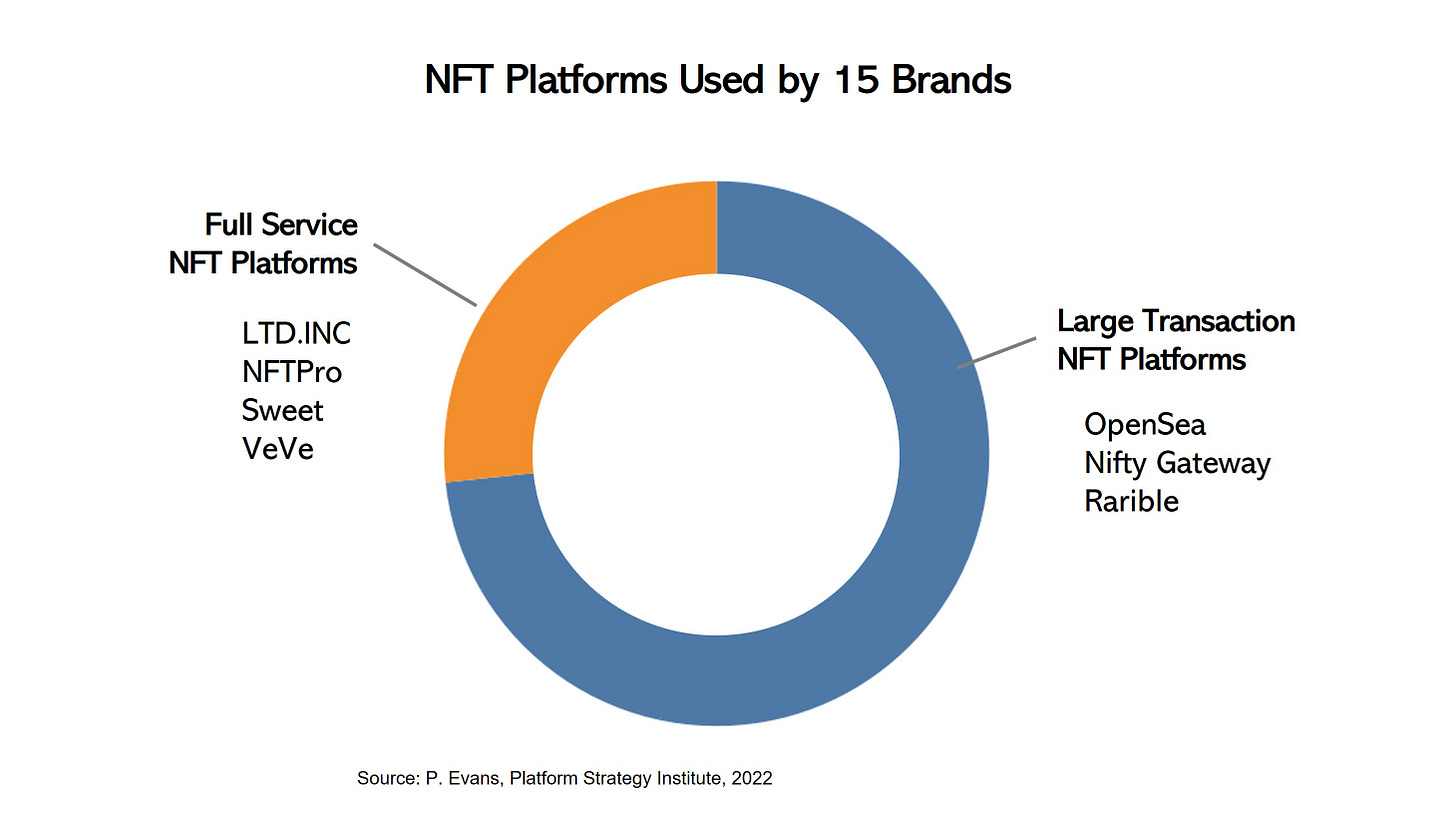Brand NFT Design & Platform Strategy
A deep dive into $30 million in primary sales by 15 major corporate projects
Non-fungible Tokens (NFTs) burst onto the scene in 2021. Until last year blockchain-based certificates were the province of small off-beat projects like Crypto Kitties. That changed last year when a convergence of factors drove billions of dollars in NFT transactions and a wave of investment in building NFT platforms.
Major brands drove a significant part of this attention. More than two dozen major brands launched NFT projects between March 2021 and March 2022. The brands that have jumped on the NFT craze span an impressive range of sectors, such as food & beverage, fashion, sports, entertainment, and automotive.
In this article, I dive into 15 major NFT brand projects. These projects have generated over $30 million in initial sales and millions more in secondary sales. It is not a comprehensive list, but it does represent a cross-section of some of the most significant projects.
Brands and NFTs
NFTs can be complex for brands to wrap their heads around and deploy. Few companies have the internal talent to design and deliver NFT projects. This is partly because the technology is new and can be applied to a host of different types of digital assets--- images, GIFs, video clips, or audio files. There is also the choice between commissioning creators, using computer generative work, or a blend of both.
But there are other deeper strategic reasons as well. NFTs projects can serve different goals. NFT projects can be philanthropic where the proceeds are given away to support a particular cause, or they can be purely commercial where the brand keeps the revenue from a sale.
There are also many tactical questions that must be addressed since NFT can be deployed in a host of ways. For example, NFTs projects can be structured as drops or as auctions. Auctions have the advantage of discovering what the market will bear but do not work well if the goal is to make the NFTs available to many buyers. Drops work better for larger numbers of NFTs but require determining the price in advance, which can be challenging. Many NFT projects have misjudged price and quantity leading to either a failure to sell out or, in other instances to underestimate demand to the degree that servers taking orders are overwhelmed and crash.1
Not surprisingly the NFT projects that brands have launched to date range widely and have relied heavily on third parties. Some have been relatively small and quirky like the early project launched by P&G’s Charmin division. That project titled Non-Fungible Toilet Paper featured 5 1:1 artwork that collectively sold for less than $10,000. Others have been much more elaborate and have engaged some of the biggest names in the NFT industry and have generated eye-popping sums. The Adidas ORIGINALS: Into the Metaverse project which took place at the end of 2021 in pulled in $23 million through the sale of 30,000 NFTs.2
Let’s look first at project design and approaches to engagement and then turn the NFT platforms brands are using to implement their NFT projects.
Project Design
A host of factors go into designing a strong NFT project. Two are worthy of special attention. One is the project’s overall objective. A project can be purely philanthropic with all the proceeds going to charity. Projects in this category include Coca-Cola’s Friendship Day Box, Cambell’s AmeriCANa, and Kia America’s Robo Dog. These projects have benefited the Special Olympics, Feeding America, and the Petfinder Foundation respectively.
On the other end of the spectrum, a project can be purely commercial. This is a larger and more diverse category, which includes projects populated by brands such as Nike, Adidas, Gucci, Budweiser, Pepsi, Wrangler, Mercedes-Benz, L’Oréal, and Marvel Comics, which is owned by Walt Disney. Some of these are run as auctions, some as fixed price drops, and a few as sweepstakes.
Brand-backed NFTs projects can be moneymakers. Dolce and Gabbana’s Collezione Genesi project brought in $6.1 million; the two Budweiser projects, Budweiser Royalty NFTs and Bud Light N3XT Collection, generated $10.5 million. Then there is the CloneX project, which stands in a class of its own. This is more of a program than a project in that it has involved multiple drops, which have generated an estimated $165 million in primary sales.3 This project was originated by RTFKT studio, a specializes in metaverse avatars and wearables. It has since been taken over by Nike when acquired RTFKT for an undisclosed sum.4
The implications for brand building are significant. With NFTs, marketing departments hold the potential to add revenue streams to what has traditionally been a cost center and driven by paid media.
Engagement
It is common to hear that NFT are all about creating communities. However, when we examine how brand NFT projects we find a much more mixed picture. Some brands have invested significant resources in community building but many have not. Even the brands that have worked to spin up a community have gone about it very differently. Some have created a dedicated internal team and set up their Discord channel to actively engage the community on a daily basis. Impressed with the fast-paced, collaborative communication, Vogue Business dubbed Discord the ‘Soho House of Web 3.0.’5
Others have invested relatively little and left the community aspect of a project to third-party providers. Communities serve a number of functions. It is a place for a user to receive the latest breaking news, get support for issues, participate in regularly scheduled free giveaways, discuss drop information & future drops. It can also be a place to complain and manipulate.
The Pepsi Mic Drop provides an example of a project with little community building. That project involved dropping 1,893 variations of a digital image of a microphone and paying tribute to Pepsi’s longstanding support of music. Access to the NFTs was free, except for the gas paid to the Ethereum network to mint the NFT. The NFTs from this drop has been actively trading on OpenSea generating nearly $10 million in transactions. The company did not establish a Discord community associated with this project or offer rewards to holders.
Lamborghini’s Space Time Memory project is another brand NFT with not community or utility. The project itself is elaborate.6 Lamborghini commissioned a well-known Swiss artist who traveled to the Sant`Agata Bolognese factory in Italy to photograph more than 1,500 individual car parts. This effort yielded 5 NFT, which were auctioned over a period of 75 hours and 50 minutes, the amount of time it took the Apollo 11 mission to blast off from earth and enter the moon’s orbit. The winners of the five auctions receive one Space Key, through which they could access the NFT by scanning the QR code on the carbon fiber. Each Space Key holds information on the carbon piece, the title and the NFT number of the digital element inscribed. The special keys were delivered to auction winners in a custom-made, metal case. While significant attention went into designing this project, no Discord was established to cultivate a community.
At the other end of the spectrum is Adidas’ Into the Metaverse. The project quickly attracted a large community of over 47,250 in the discord channel it set up. The project has multiple phases. It also involves blending digital products with real product redemptions. NFT holders can redeem physical merchandise by visiting the Into the Metaverse website and verifying token ownership. When users claim their physical product, their NFT is burned (destroyed).
Mercedes-Benz’s NFT project represents another approach. Rather than establishing an internal team and Discord channel, the company turned to a third party to establish and manage the community. Mercedes-Benz assigned community engagement to art2people. This is the same company that it engaged to contract the artwork. So, event though the company has strong brand equity and global reach (the company sold 2.4 million vehicles in 2021), there are only about 1,000 users in the art2people discord associated with the NFT project. This has caused some users to complain that the project is “dead” and not committed to growing a robust community.
Brand Choice of NFT Platform
In addition to purpose and engagement, brands must also select what platforms to use to deliver their NFT projects.7 These platforms provide key functions. They provide the blockchain technology required to verify the provenance of digital content. They also provide the place where primary market transactions take place. In many cases, they also provide a secondary marketplace where the NFTs can be displayed and traded. Some platforms go even further and provide additional services, such as design and marketing.
Approximately three-fourths of the 15 brands examined in this sample chose either OpenSea, Nifty Gateway, or Rarible. These are multisector platforms that host NFTs across art, music, sports, and other sectors. These platforms focus on providing transaction services and are among the largest NFT platforms. They, therefore, offer deeper and more liquidity markets for sellers. This is especially true for OpenSea, which has emerged as the largest NFT marketplace, now transacting billions in NFTs per month.8
One fourth of the brands selected more full-service NFT solution providers. For example, Disney (Marvel) selected VeVe, a small company based in New Zealand to manage its NFT offerings. VeVe has emerged as the largest mobile-first digital collectibles platform. Kia selected Sweet, a New York-based startup which provides NFT creative services, token minting across multiple blockchains, token mechanics/gamification, and distribution to consumers. Sweet also operates an NFT marketplace (accessible via web and mobile) and a user-friendly NFT wallet where users can store their digital collectibles. Lamborghini went with NFTPro based in San Francisco. This is an enterprise-level solution provider that focuses on providing white-label NFT solutions for brands. Anheuser-Busch InBev (Bud Light N3XT) selected VaynerNFT, a spinoff from Vayner Media a media agency founded Gary Vaynerchuck’s media agency.9 Finally, Wrangler selected LTD.Inc is a small London-based company that partners with artists, creators, and brands to launch physical + digital NFT collections and in real life (IRL) activations.
Conclusion
How deeply NFTs will become integrated with future brand strategy remains a matter of significant debate. Some see NFTs as a powerful game-changer and argue that NFT technology and utility will become part of every product.10 Proponents argue that NFTs are not just a new technology, but also establish a new relationship between creators, companies and brands and their audience. Others take a more circumspect view, suggesting that NFT is a fad or worse a tool for Ponzi schemes and other unsavory practices.11
While it is too soon to declare a winner in this debate, this review of 15 projects highlights some important patterns.
First, is that the level of engagement and community building varies widely. So far, when a project is earmarked for charity, brands are not investing in community building.
Second, even when the projects have commercially driven goals, the investment in community building varies significantly. Community building is stronger when the brand takes on this role and builds a dedicated internal team. It is much weaker when it is outsourced to a third party.
Third, well-designed projects can generate substantial revenue. So instead of paying an agency to promote a product or general brand building, brands can generate millions in revenue to fund engagement campaigns that gain additional energy and creativity by decentralized ownership of the NFTs. However, this also sets up expectations among the NFT holders. They have paid into a project, own the NFTs, and therefore have a real stake in how the project evolves. If these expectations are not managed well, including a clear road map, continuous communication, and real utility, then a project can go south very quickly.
» Coming Soon «
Top 100 NFT Platform Database
I’ve been working on a detailed database of NFT platforms with the team at Ecodynamics. The database is designed specifically for brand managers, strategists and product managers seeking to gain a more comprehensive understanding of the NFT Platform landscape. Pre-register for 2022 Top 100 NFT Platform Database here.









